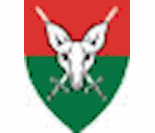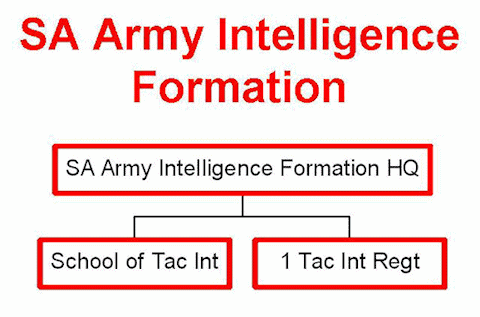Intelligence Formation
 The Vision is to create an environment in which the units under command can prepare combat ready and supported intelligence user system. The Mission is to prepare and provide Combat Ready and supported Intelligence User Systems for the SA Army.
The Vision is to create an environment in which the units under command can prepare combat ready and supported intelligence user system. The Mission is to prepare and provide Combat Ready and supported Intelligence User Systems for the SA Army.
Military Intelligence is a disciplined process of collecting, analyzing, and interpreting battlefield information to support the decision-making process of commanders in combat. The Military Intelligence process is conducted continuously before, during, and after hostilities from the strategic down to the tactical level. Military Intelligence is a critical underpinning for all Army operations.
Military intelligence is intelligence on any foreign military or military-related situation which is significant to military policy-making or the planning and conduct of military activities. It is the product of gathering information about foreign military capabilities, intentions, plans, dispositions, and equipment analyzing the contents of that information and disseminating the findings to decision-makers, combat troops, and other recipients.
Military intelligence appears in three basic forms strategic, operational, and tactical. Strategic intelligence is intelligence that is required for the formulation of strategy, policy, and military plans and operations at national and theater levels. It involves a focus on overarching factors such as foreign geography, infrastructure, and force planning, or long-term trends such as the application of new tactics, techniques, and procedures or the development of new resources. It is an important tool in the effort to anticipate and counter threats throughout the world.
Operational intelligence is intelligence that is required for planning and conducting campaigns and major operations to accomplish strategic objectives within theaters or operational areas. It assumes a different approach than strategic intelligence by focusing on narrower, but significant, theater-oriented military responsibilities. Finally, tactical intelligence is intelligence that is required for planning and conducting tactical military operations at the local level. It concerns information about the enemy that is designed to help locate the enemy and decide which tactics, units, and weapons will most likely contribute to victory in an assigned area, and when properly applied, it can be a signifi cant force multiplier.
The intelligence process services the need for all three types of intelligence. The first step, information gathering, consists of collecting data and making it available for analysis. A common method of information gathering is the use of unclassified “open sources” such as websites, television, newspapers, radio, or openly published government studies. Often, this open source intelligence OSINT provides such basic information as population statistics, military maneuvers, and political, social, and cultural trends.
Open sources sometimes do not supply enough information, and other techniques are necessary. Analysis of aerial imagery is one commonly employed method. A great deal of information on infrastructure, military bases, and even troop movements, can be gleaned from photo interpretation of detailed, high-altitude photography, also known as IMINT, or imagery intelligence. Human intelligence (HUMINT) involves the overt or covert use of human sources to gather information. Signals intelligence (SIGINT) involves collecting information by listening to enemy radio broadcasts and other electronic means of communication. All of these disciplines provide vital intelligence that, when properly analyzed, can provide a significant benefit to warfighters and policymakers.
The second step of the intelligence process is analysis. Intelligence analysts pull together information gathered from many sources to produce all-source, finished intelligence that involves local, national, and global issues that may influence foreign threats. They assess scientific, technical, tactical, diplomatic, military, organizational, or political changes in combination with factors such as geography, demographics, and industrial capabilities. The goal is to anticipate and respond to dangers as well as assess enemy capabilities, intentions, and vulnerabilities. The finished intelligence they produce can be either strategic, tactical, or operational.
The third step of the intelligence process is actually made up of two activities: production and dissemination. Once analysts have made their determinations, they compose finished intelligence reports for both military and civilian officials. Intelligence officers then disseminate these products to relevant decisionmakers, who decide on a detailed plan of action. One of the intelligence officer’s primary duties is to anticipate the needs of decisionmakers and react to specific requests for information. Intelligence officers often work very closely with policymakers and warfighters to anticipate information requirements and to more sharply hone the finished intelligence provided by analysts.

|
NEWSLETTER
|
| Join the GlobalSecurity.org mailing list |
|
|
|

